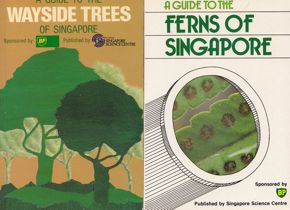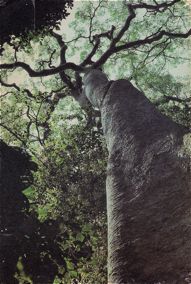This posts provides lists of books that can be used to help identify the commoner plants that are closely related to birds LINK. It is not always easy to identify plants, even for botanists. This is especially so with forest plants and plants without flowers and/or fruits. As such, the lists start from simple pictorial books to the more complex ones that provide line drawings and keys to identification. Regional floras are also provided as these are more comprehensive in their treatment of species. They cater mainly for plant taxonomists.
For students and those who are new to plants, the Singapore Science Centre’s pocket sized booklets are ideal (above). They are lavishly illustrated with photographs and cost only S$5 per copy. Only the more common species are dealt with and these can be found in the region. So far 46 booklets have been published, most of which deal with animals and their habitats.
1. Ng, A., A. Ng, B. Lee, A. L. Chua, S. G. Goh, J. T. K. Lai, G. C. Tan & V. D’Rozario, 2005. A guide to the fabulous figs of Singapore. Singapore Science Centre. 152spp.
2. Ng, P. K. L. & N. Sivasothi (eds.), 1999. A guide to the Mangroves of Singapore 1. The ecosystem and plant diversity. Singapore Science Centre. 160pp.
3. Tan, H. T. W. (ed.), 1995. A guide to the threatened plants of Singapore. Singapore Science Centre. 158 pp.
4. Wee, Y. C., 1981. Trees. Science Council of Singapore.
5. Wee, Y. C., 1983. A guide to the ferns of Singapore. Singapore Science Centre.
6. Wee, Y. C., 1990. A guide to the wayside trees of Singapore. Singapore Science Centre. (2nd ed.) 160 pp.
7. Wee, Y. C., 1992. A guide to medicinal plants. Singapore Science Centre. 160 pp.
8. Wee, Y. C., 2003. A guide to herbs and spices. Singapore Science Centre. 165 pp.
These are lavishly illustrated books on the more common garden and wayside plants. Easy to use, they provide short notes on the plants covered.
9. Ng, F. S. P., 2006. Tropical horticulture and gardening. Kuala Lumpur: Clearwater Publication. 361 pp.
10. Polunin, I., 1987. Plants and flowers of Singapore. Times Editions, Singapore. 160pp.
11. Polunin, I., 2004. Plants and flowers of Malaysia. Times Editions, Singapore. 169pp.
12. Wee, Y. C., 2005. Ferns of the tropics. Times Editions-Marshall Cavendish, Singapore. 2nd ed. 190 pp.
Among the illustrated books on the common trees, shrubs and herbs used in urban plantings, Boo et al. (2006) is useful if you want just to get a name to a plant – just browse through and compare pictures. It includes nearly all plants used to provide urban greenery in Singapore, especially the newly introduced. For details of the plants, you need to consult Tee et al. (2009) and Wee (2003). Yong et al. (2010) is useful for the identification of plants growing in and near water.
13. Boo, C. M., Omar-Hor, K. & Ou-Yang, C. L. (2006). 1001 garden plants in Singapore. Singapore: National Parks Board. 798 pp.
14. Tee, S. P, & M. L. Wee (eds.), 2001. Trees of our garden city – A guide to the common trees of Singapore. National Parks Board, Singapore. 202pp.
15. Tee, S. P., W. K. Yong, J. S. C. Ng & G. Z. M. Ong (eds.), 2009. Trees of our garden city – A guide to the common trees of Singapore. National Parks Board, Singapore. 384pp.
16. Wee, Y. C. (2003). Tropical trees and shrubs – A selection for urban plantings. Sun Tree Pub., Singapore. 392pp.
17. Yong, J. W. H., P. K. Tan, N. H. Hassan & S. N. Tan, 2010. A selection of plants for greening of waterways and waterbodies in the tropics. National Parks Board, Nanyang Technological University and Public Utilities Board. 480pp.
We have a good collection of books dealing with tropical trees since Corner published his classic in 1940 (see #22). The other four books listed below are excellent in their presentation and colour photographs, targeting different regions.
18. Barwick, Margaret, 2004. Tropical and subtropical trees. A worldwide encyclopaedic guide. London: Thames & Hudson. 484pp.
19. Gardner, S., P. Sidisunthorn & V. Anusarnsunthorn, 2000. A field guide to forest trees of Northern Thailand. Kobfai Publishing Project, Bangkok. 545pp.
20. LaFrankie, Jr., J. V., 2010. Trees of Tropical Asia. An illustrated guide to diversity. Black Tree Publications, Inc., Philippines. 748pp.
21. Wong, K. M. & A. S. Kamariah (eds.), 1999. Forests and trees of Brunei Darussalam. Universiti Brunei Darussalam, Brunei. 109pp.
These are the plant books I used when reading botany in the university. They may be outdated but still useful, until new and revised books become available (see below).
22. Corner, E. J. H. (1988). Waysides trees of Malaya. Vol. 1-2. Malayan Nature Society, Kuala Lumpur. 861pp. (above left).
Gilliland, H. B., 1971. A revised floras of Malaya. Vol. III Grasses of Malaya. Botanic Gardens Singapore. 319 pp.
23. Henderson, M.R. (1954). Malayan wild flowers – Monocotyledons. Malayan Nature Society, Kuala Lumpur. 357 pp.
24. Henderson, M.R. (1959). Malayan wild flowers – Dicotyledons. Malayan Nature Society, Kuala Lumpur. 478 pp.
25. Holttum, R. E. (1966). A revised flora of Malaya. II Ferns of Malaya. Govt. Printing Office, Singapore (2nd ed.). 653 pp. (above centre)
26. Keng, H. (1990). The concise flora of Singapore: Gymnosperms and dicotyledons Singapore University Press. 222 pp. (above right)
27. Keng, H., S. C. Chin & H. T. W. Tan, 1990. The concise flora of Singapore Vol. II: Monocotyledons. Singapore University Press & National Parks Board. 215 pp.
Floras are more for the plant taxonomists. They are included here for information, in case there are those who are advanced in their knowledge on plants.
28. Tree Flora of Malaya, started in 1965 and completed in 1989, covers 100 families of Malayan trees. Initiated by the Forest Research Institute of Malaysia, all four volumes were published by Longman Malaysia. Volumes 1 and 2 were edited by T. C. Whitmore while volumes 3 and 4 by F. S. P. Ng.
29. Tree Flora of Sabah and Sarawak is a joint project be the Forest Research Institute of Malaysia, Sabah Forestry Department and Sarawak Forestry Department. Initiated in 1991, the seventh volume was published in 2011, with E. Soepadmo as the chief editor. One more volume is due.
30. Flora of Thailand deals with the entire vascular flora, not just trees. Initiated in 1963 it has completed 12 volumes.
31. Flora of Peninsular Malaysia aims at a comprehensive revision of all species of vascular plants in the country, including trees. Once completed, this will make all books on the flora of the Malay Peninsula published during the colonial years obsolete (see 22-25). It is being produced in two series, Series I for Ferns and Series II for Seed Plants. So far, only a few volumes have been completed.
32. PROSEA’s (Plant Resources of South-East Asia) series of 19 volumes is useful as they cover plants of the region. Each of the 19 volumes is based on a specific agricultural product (edible fruits and nuts, timber, medicinal and poisonous plants, spices, etc.). The first volume was published in 1989 and the last in 1999, Authors come from the international community. The volumes provide useful information on the plants and their economic uses. Illustrations come in selective sketches of the plants.
YC Wee
Singapore
September 2012


























One Response
Thanks YC Looks like I have to start another routine of going to the State Library and make a purchase of a couple of useful ones to have handy around the house.
Cheers,
Daisy